�
BooK 2 - EcoNOMics
Reading Assignments
Study Session 4
-Economics:
and Learning
Microeconomic
Outcome Statements
........................................ 3
........................................... 8
...................................... 124
............................ 209
.......................................................................................... 249
in a Global Context
Economics
Analysis
Study Session
5 -Economics: Macroeconomic
Analysis
Study Session 6 -Economics:
Self-Test: Economics
Formulas
............................................................................................................
Index .................................................................................................................
253
257
SCHWESERNOTES™ 2013 CPA LEVEL I BOOK 2: ECONOMICS
©20 12 Kaplan,
Published
reserved.
Inc. All rights
in 2012 by Kaplan,
Inc.
the United States
Printed in
ISBN: 978-1-4277-4268-1
PPN: 3200-2845
of America.
I 1-4277-4268-5
If this book does not
distributed
of global copyright
have the hologram with the Kaplan Schweser logo on the back
cover, it was
without permission
of Kaplan Schweser,
a Division of Kaplan, Inc., and is in direct violation
laws. Your assistance
in pursuing potential
violators
of this law is greatly appreciated.
owned
CFA Institute
(formerly
disclosure
for these materials:
"Copyright,
Management and Research)
offered by Kaplan
the Association
for Investment
disclaimer:
"CFA® and Chartered Financial Analyst® are trademarks
contained within this text are the copyrighted
from 2013 Learning Outcome Statements,
CFA Institute
Standards
Required CFA Institute
by CFA Institute.
does not endorse, promote, review, or warrant the accuracy of the products or services
Schweser."
Certain materials
is the copyright
republished
Materials,
Performance
These materials
duplication
Your assistance
Disclaimer:
CFA Institute
topics contained in the readings referenced
their accuracy cannot be guaranteed
authors of the referenced
2012, CFA Institute.
Level I, II, and III questions
Conduct, and CFA Institute's
All Rights Reserved."
from CFA Institute.
may not be copied without written permission
in their 2013 CFA Level I Study Guide.
Standards
with permission
nor endorsed or sponsored these Notes.
should be used in conjunction
readings as set forth by
contained in these Notes
However,
nor is any warranty conveyed as to your ultimate exam success.
The
and is believed to be accurate.
by CFA Institure
The information
with the original
property of CFA Institute.
Reproduced and
of this law is greatly appreciated.
from the author. The unauthorized
laws and the CFA Institute
Code of Ethics.
of these notes is a violation
of global copyright
in pursuing potential
violators
The SchweserNores
Global Investment
of Professional
readings have
covers
The following
from CFA ® Program
Page 2
Inc.
©2012 Kaplan,
�
READING AssiGNMENTS AND
LEARNING OuTCOME STATEMENTS
is a review
of the Economics principles designed to address
the
outcome
The following material
learning
STuDY SESSION
Economics,
statements set forth by CPA Institute.
AssiGNMENTS
4 READING
Volume 2 (CFA Institute,
CPA Program Curriculum,
13. Demand and Supply Analysis:
Introduction
14. Demand and Supply Analysis:
Consumer
15. Demand and Supply Analysis:
The Firm
16. The Firm and Market Structures
2013)
Demand
page 8
page 45
page 57
page 92
STuDY SESSION
Economics,
5 READING
AssiGNMENTS
CFA Program Curriculum,
Volume 2 (CFA Institute,
2013)
and Economic
Growth
Output,
17. Aggregate
18. Understanding
19. Monetary
Business
and Fiscal
Policy
Prices,
Cycles
STuDY SESSION
Economics,
6 READING
AssiGNMENTS
Volume 2 (CFA Institute,
CFA Program Curriculum,
Flows
Trade and Capital
2013)
20. International
21. Currency
Rates
Exchange
page 124
page 155
page 178
page 209
page 230
©20 12 Kaplan,
Inc.
Page 3
�
Book 2 - Economics
Reading
Assignments
and Learning Outcome Statements
LEARNING
OuTCOME STATEMENTS (LOS)
STUDY SESSION 4
The topical coverage corresponds with the following CFA Institute
assigned
reading:
13. Demand and Supply Analysis:
Introduction
The candidate
a. Distinguish
b. Explain
c. Describe
should be able to:
among types of markets. (page 8)
the principles
causes of shifts in and movements
of demand and supply.
(page 9)
along demand and supply curves.
(page 1 1)
d. Describe
the process
of aggregating
demand and
and mechanisms
between stable
and unstable
by which markets
supply curves,
achieve
equilibria
the concept
equilibrium.
(page 12)
instances
of such
and identifY
of
e. Distinguish
equilibrium,
equilibria. (page
15)
f. Calculate
and interpret
individual and
aggregate
demand, inverse
and interpret
individual
and aggregate
demand and
demand and supply
supply functions
(page 16)
curves.
g. Calculate
and interpret
h. Describe
with a non-equilibrium
the types of auctions
(page 16)
(page 18)
and interpret
consumer
1. Calculate
the amount of excess demand or excess
price.
(page 16)
and calculate
the winning
price(s)
of an auction.
supply associated
surplus,
producer
surplus,
and total surplus.
J. Analyze the effects of government regulation
and intervention
on demand and
supply.
(page 22)
the effect of the introduction
a price floor or ceiling)
and interpret
price,
and the removal
on price and quantity.
income,
(page 22)
elasticities
and cross-price
of demand and
of a market interference
(e.g.,
k. Forecast
1. Calculate
describe
factors that affect each measure. (page
31)
The topical coverage corresponds with the following CFA Institute
assigned
reading:
14. Demand and Supply Analysis:
Consumer Demand
should be able to:
The candidate
a. Describe consumer
b. Describe
choice theory and
indifference
curves,
in decision
c. Calculate
d. Determine a
the use of
making. (page 46)
and interpret
consumer's
(page 46)
a budget constraint.
equilibrium
and income effects. (page 49)
e. Compare substitution
f. Distinguish
and Veblen goods in this context.
(page 52)
(page 49)
utility
theory.
(page 45)
sets, and budget constraints
opportunity
bundle of goods based
on utility
analysis.
between normal goods and inferior goods, and explain
Giffen goods
The topical coverage corresponds with the following CFA Institute
assigned
reading:
1 5. Demand and Supply Analysis:
The Firm
The candidate
a. Calculate,
should be able to:
interpret,
and economic
and interpret
b. Calculate
profit,
(page 61)
and compare accounting
rent. (page
57)
profit,
economic
profit,
normal
and compare total,
average,
and marginal
revenue.
Page 4
©2012 Kaplan,
Inc.
�
Reading
Assignments
and Learning Outcome Statements
Book 2 - Economics
c. Describe
d. Calculate
the firm's factors of production.
(page 63)
and interpret
average,
total,
marginal, fixed,
and variable
costs.
(page 65)
e. Determine
f. Explain
g. Describe approaches
and describe
how economies
breakeven
of scale and diseconomies
and shutdown
points of production.
(page 69)
fect costs. (page
of scale af
73)
level of output.
the profit-maximizing
to determining
(page 74)
and describe
J· Calculate
k. Describe
h. Distinguish
1. Distinguish
supply of each. (page 78)
and long-run profit
maximization.
between short-run
among decreasing-cost, constant-cost,
and increasing-cost
the long-run
and interpret
the phenomenon
the profit-maximizing
and average
marginal
level of an input.
of labor.
and calculate
(page 8 1 )
that minimizes
product
returns
of diminishing
of resources
interpret
I. Determine
The topical coverage corresponds with the following CPA Institute
the optimal combination
utilization
reading:
assigned
marginal,
cost. (page 8 1 )
total,
(page 80)
(page 77)
and
industries
16. The Firm and Market Structures
The candidate
a. Describe
should be able to:
the characteristics
of perfect
competition,
monopolistic
competition,
oligopol
b. Explain
y, and pure monopoly. (page 92)
the relationships
between price,
marginal
revenue, marginal
cost,
economic
(page 94)
profit, and the elasticity
of demand under each market
structure.
c. Describe
d. Describe
the firm's supply function under each market structure.
(page 1 12)
for firms under each
and determine
the optimal price and output
market structure.
(page 94)
e. Explain
factors affecting long-run
equilibrium
under each market structure.
(page 94)
f. Describe pricing
strategy
g. Describe
under each market structure.
measures
of concentration
the use and limitations
(page 112)
in identifying.
(page 1 13)
h. Identify
the type of market structure
a firm is operating
within.
(page 1 15)
STUDY SESSION 5
The topical coverage corresponds with the following CPA Institute
assigned
reading:
17. Aggregate
The candidate
a. Calculate
Output, Prices,
should be able to:
and explain
and Economic
Growth
gross domestic product
(GDP) using
expenditure and
income approaches.
(page 124)
b. Compare the sum-of-value-added
and value-of
-final-output
methods of
calculating
GDP. (page 125)
c. Compare nominal
and real GDP and calculate
and interpret
the GDP deflator.
(page 125)
d. Compare GDP, national
income,
personal
income,
and personal
disposable
income. (page
127)
e. Explain
balance,
relationship
the fundamental
and the trade balance.
the IS and LM curves and how they combine to generate
among saving,
(page 128)
investment,
the fiscal
the aggregate
f. Explain
demand curve. (page 129)
©20 12 Kaplan,
Inc.
Page 5
�
Book 2 - Economics
Reading
Assignments
and Learning Outcome Statements
g. Explain
h. Explain
the aggregate
the causes of movements along and
supply curve in the short run and long run. (page
shifts in aggregate
demand and
134)
supply curves.
(page 135)
1. Describe
how fluctuations
in aggregate
demand and aggregate
supply cause short
run changes
in the
economy and the business
how a short run macroeconomic
J· Explain
or below full employment.
k. Analyze the effect of combined
(page 140)
cycle.
(page 139)
equilibrium
may occur at a level above
changes
in aggregate
supply and demand on the
economy.
1. Describe
(page 141)
the sources,
(page 144)
measurement,
and sustainability
of economic
growth.
m. Describe
the production
function approach
to analyzing
the sources
of economic
growth. (page 145)
n. Distinguish
components
between input growth and growth of total factor productivity
of economic
growth. (page 146)
as
The topical coverage corresponds with the following CPA Institute
assigned
reading:
18. Understanding
Business
Cycles
should be able to:
The candidate
a. Describe
b. Explain
the business
the typical
cycle and its phases.
(page 1 55)
patterns
of resource
use fluctuation,
housing
sector
activity,
trade sector
activity,
as an economy moves through the business
and external
cycle.
of the business
theories
types of unemployment
inflation,
hyperinfla
the construction
measures,
(page 1 56)
c. Describe
d. Describe
e. Explain
f. Explain
g. Compare inflation
h. Distinguish
1. Describe economic
J· Identify
between cost-push
the past, current,
indicators,
of indices
or expected
(page 170)
indicators.
based on economic
(page 1 59)
cycle.
and measures of
tion, disinflation,
used to measure
and deflation. (page 161)
(page 162)
inflation.
unemployment.
(page 160
including
their uses and limitations.
(page 165)
and demand-pull
including
inflation.
(page 167)
their uses and limitations.
(page 169)
future business
cycle phase of an economy
The topical coverage corresponds with the following CPA Institute
assigned
reading:
19. Monetary and Fiscal Policy
and fiscal
and definitions
policy. (page 178)
of money. (page 178)
process.
(page 179)
of the demand for and supply of money. (page 1 8 1)
of central
banks. (page 183
and unexpected.
(page 1 84)
of monetary
of effective central
banks. (page 1 87)
implementation
policy. (page
186)
between monetary
policy
188)
rates. (page
and economic
growth,
be able to:
money creation
the costs of expected
The candidate should
a.
b.
c.
d.
e.
f.
g.
h.
l.
Compare monetary
Describe
functions
Explain the
Describe
theories
the Fisher effect. (page 183)
Describe
Describe the roles
and objectives
Contrast
Describe the
Describe
Explain
inflation,
Contrast
banks. (page 189)
Determine
(page 190)
Describe
the qualities
the relationships
and exchange
interest,
the use of inflation,
the limitations
a monetary
whether
J 0
1.
m.
k.
interest
rate, and
exchange rate targeting
by central
policy
is expansionary
or contractionary.
of monetary
policy.
(page 190)
Page 6
IB
©2012 Kaplan,
Inc.
�
Reading
Assignments
and Learning Outcome Statements
Book 2 - Economics
the roles and objectives
n. Describe
o. Describe the tools
of fiscal
of fiscal policy.
(page 192)
policy, including
their advantages
and disadvantages.
(page 1 93)
p. Describe
the arguments
for and against
being concerned
with the size of a fiscal
deficit (relative
to GDP). (page 195)
q. Explain
the implementation
of fiscal
policy
and the difficulties
of
implementation.
(page 196)
r. Determine
s. Explain
the interaction
of monetary
policy is expansionary
and fiscal policy.
(page 198)
or contraction
ary. (page 197)
whether
a fiscal
20. International
STUDY SESSION 6
The topical coverage corresponds with the following CFA Institute
assigned
reading:
Trade and Capital Flows
to:
The candidate
should be able
a. Compare gross domestic
product
b. Describe
c. Distinguish between comparative
d. Explain
and gross national
trade.
and costs of international
the Ricardian
advantage
and Heckscher-Ohlin
in each model. (page 214)
comparative
the benefits
advantage
product.
(page 2 1 0)
and absolute
models of trade and the source(s)
advantage.
(page 2 1 1)
of
(page 2 1 0)
e. Compare types of trade and capital
restrictions
and their economic implications.
(page 2 1 5)
f. Explain
economic
g. Describe
unions.
the balance
(page 2 1 8)
motivations
for and advantages
of trading
blocs,
common markets,
and
of payments accounts
including
their components.
(page 220)
h. Explain
how decisions
by consumers,
firms, and governments
affect the balance
of payments.
(page 221)
1. Describe
functions
including
trade,
World Trade Organization.
(page 222)
and objectives of the international
organizations that
facilitate
the World Bank, the International Monetary
Fund, and the
The topical coverage corresponds with the following CFA Institute
assigned
reading:
21. Currency
Exchange Rates
The candidate
a. Define an exchange rate
should be able to:
and spot
b. Describe
and forward exchange rates.
functions
and distinguish
(page 230)
of and participants
in the foreign exchange
between nominal
market.
and real exchange rates
(page 232)
the percentage
change in a currency
relative
to another
c. Calculate
currency.
d. Calculate
e. Convert
and interpret
(page 233)
and interpret
forward quotations
into outright
forward quotations.
currency
cross-rates.
(page 233)
on a points
expressed
(page 234)
relationship
between spot rates,
basis or in percentage
terms
f. Explain
the arbitrage
forward rates and interest
rates.
(page 235)
g. Calculate
and interpret
a forward rate consistent
with a spot rate and the interest
rate in each currency. (page 236)
h. Describe
1. Explain
exchange
the impact of exchange
rate regimes.
(page 237)
rates on countries'
international
trade and capital
flows. (page 238)
©20 12 Kaplan,
Inc.
Page 7
�
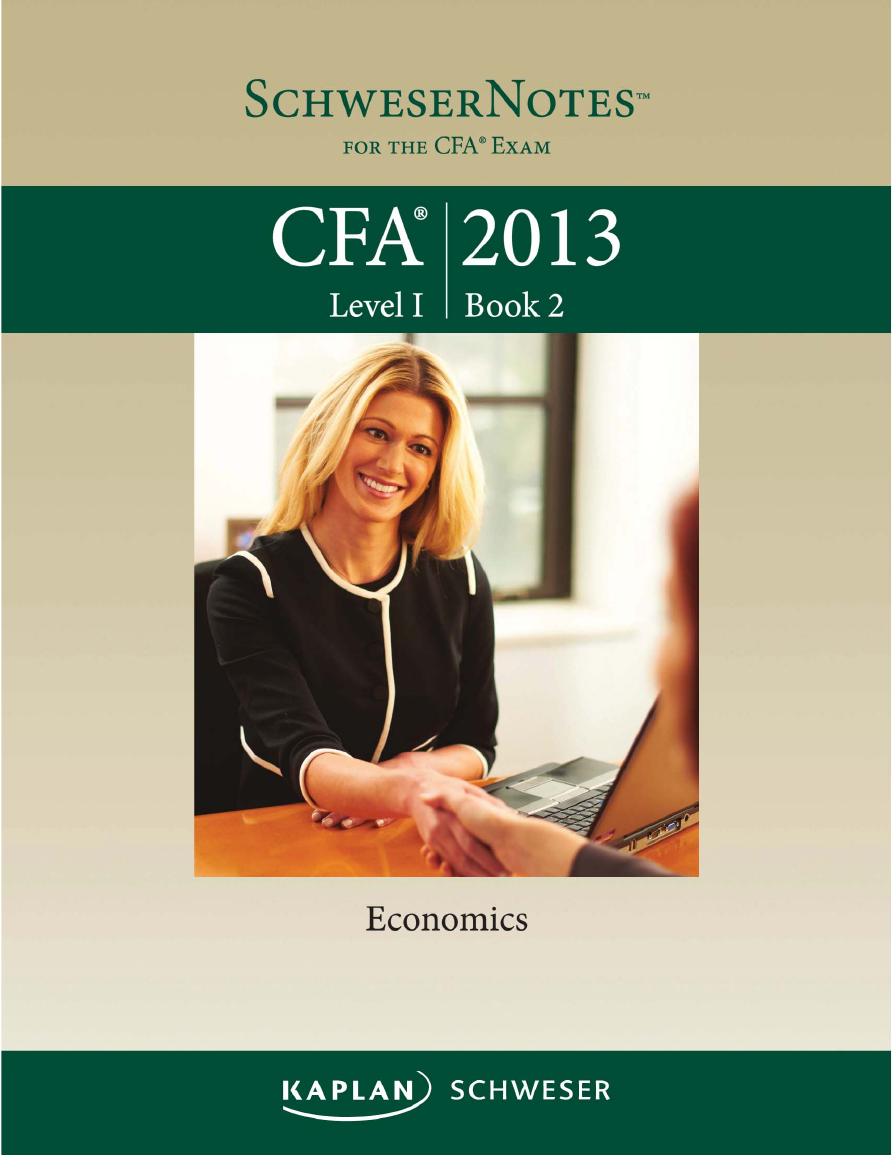
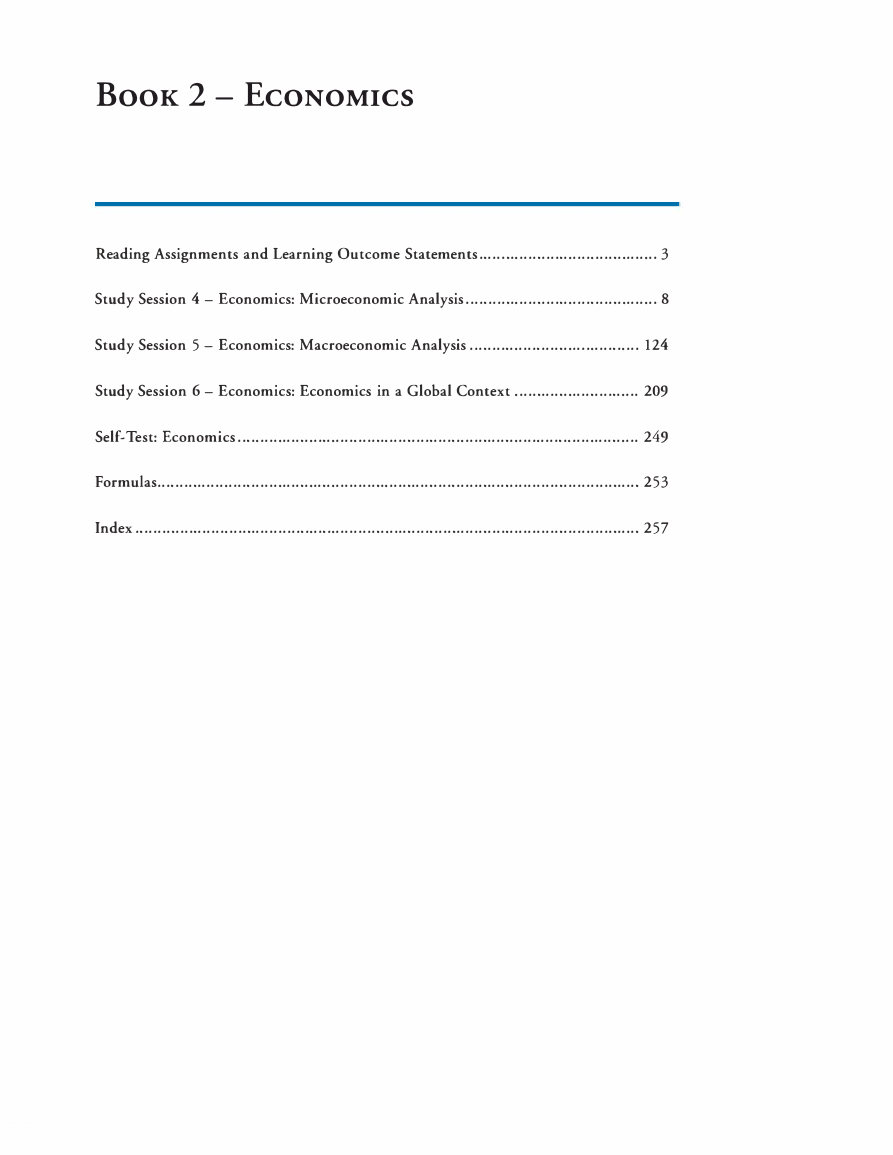

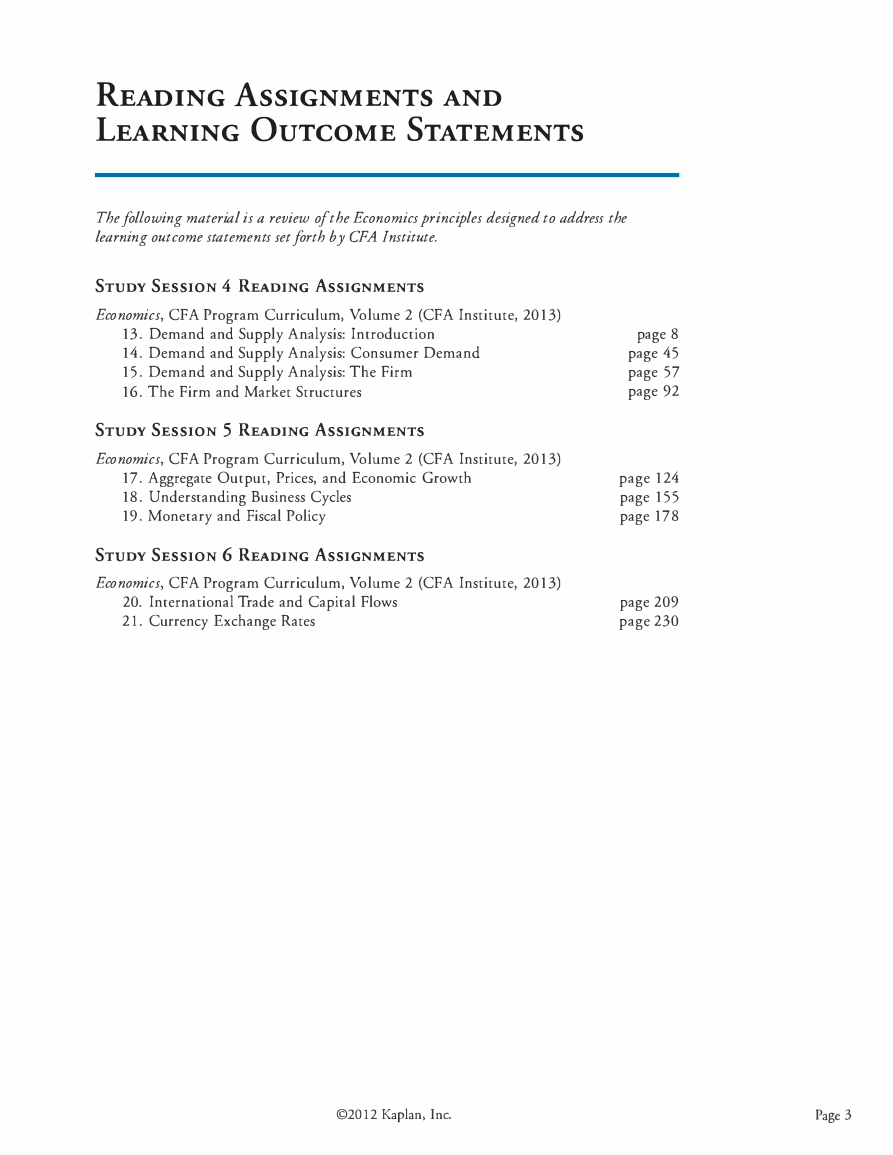
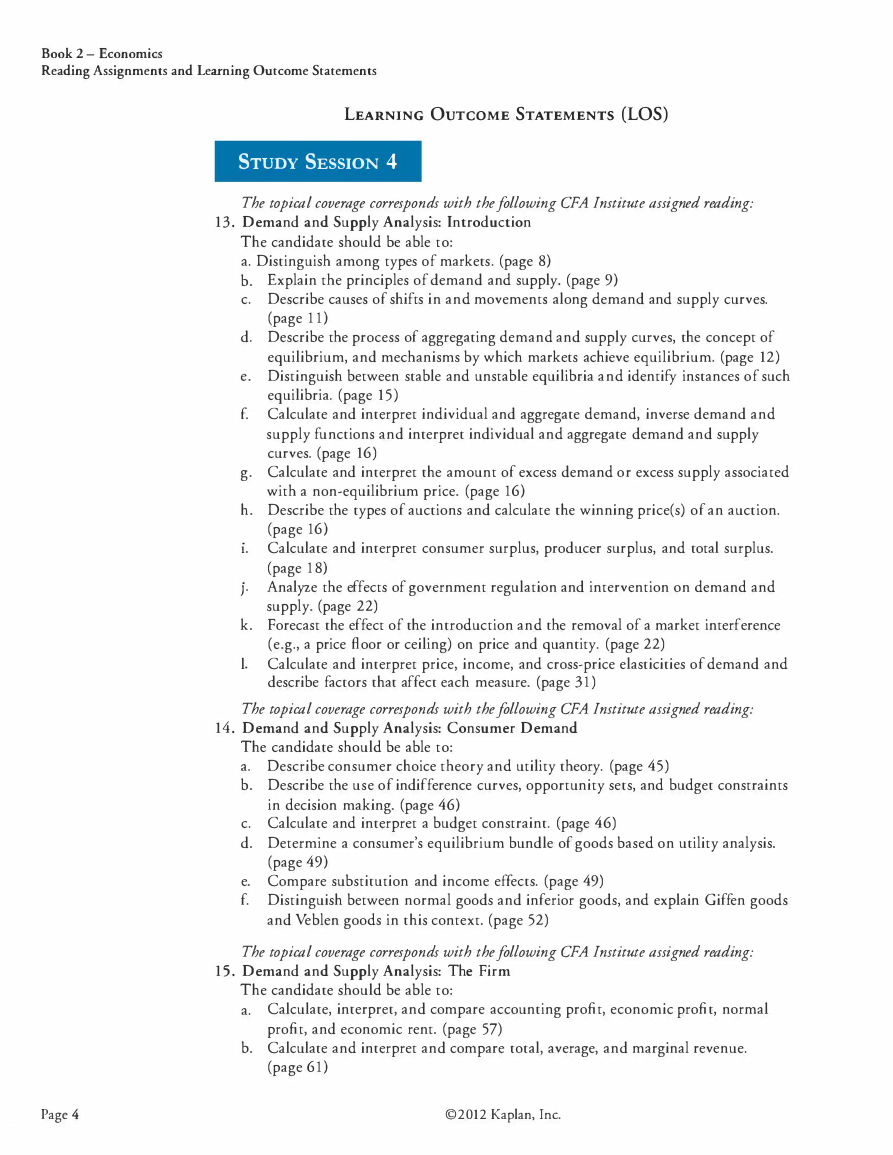
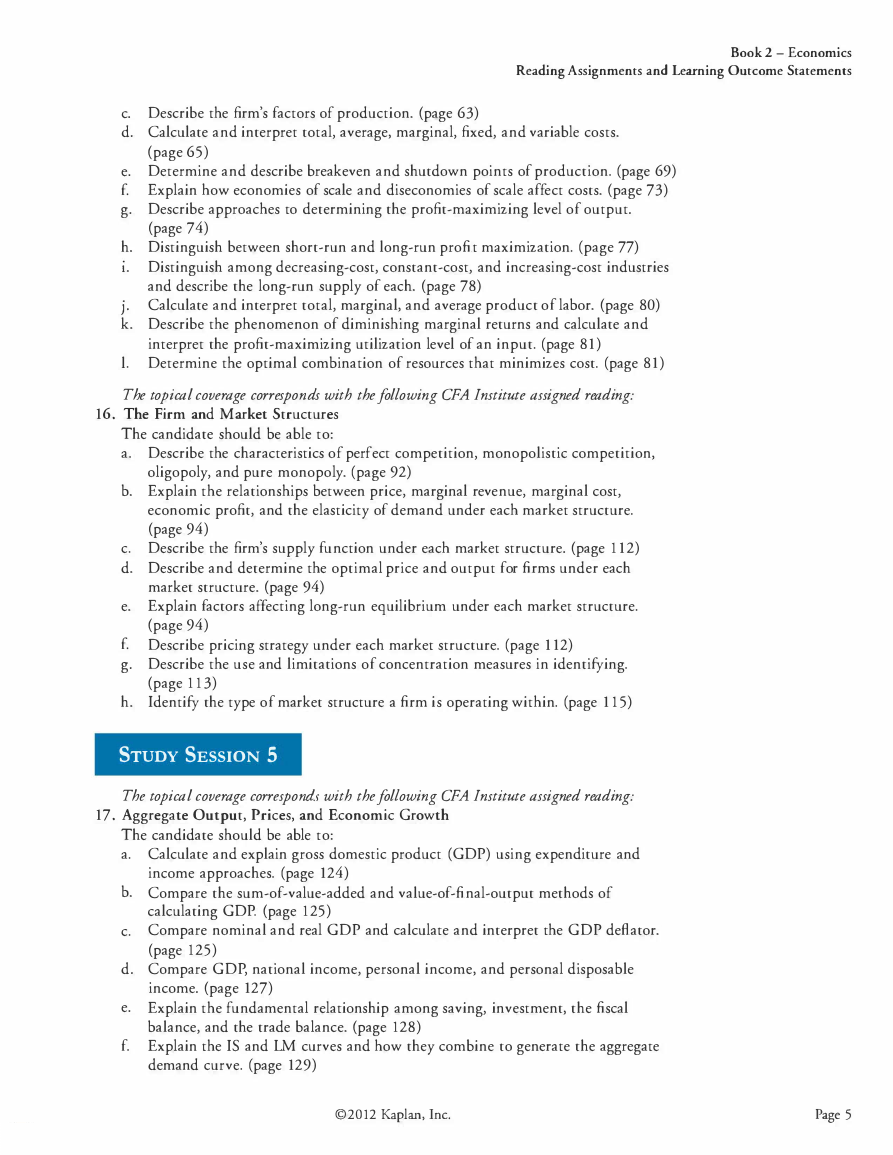
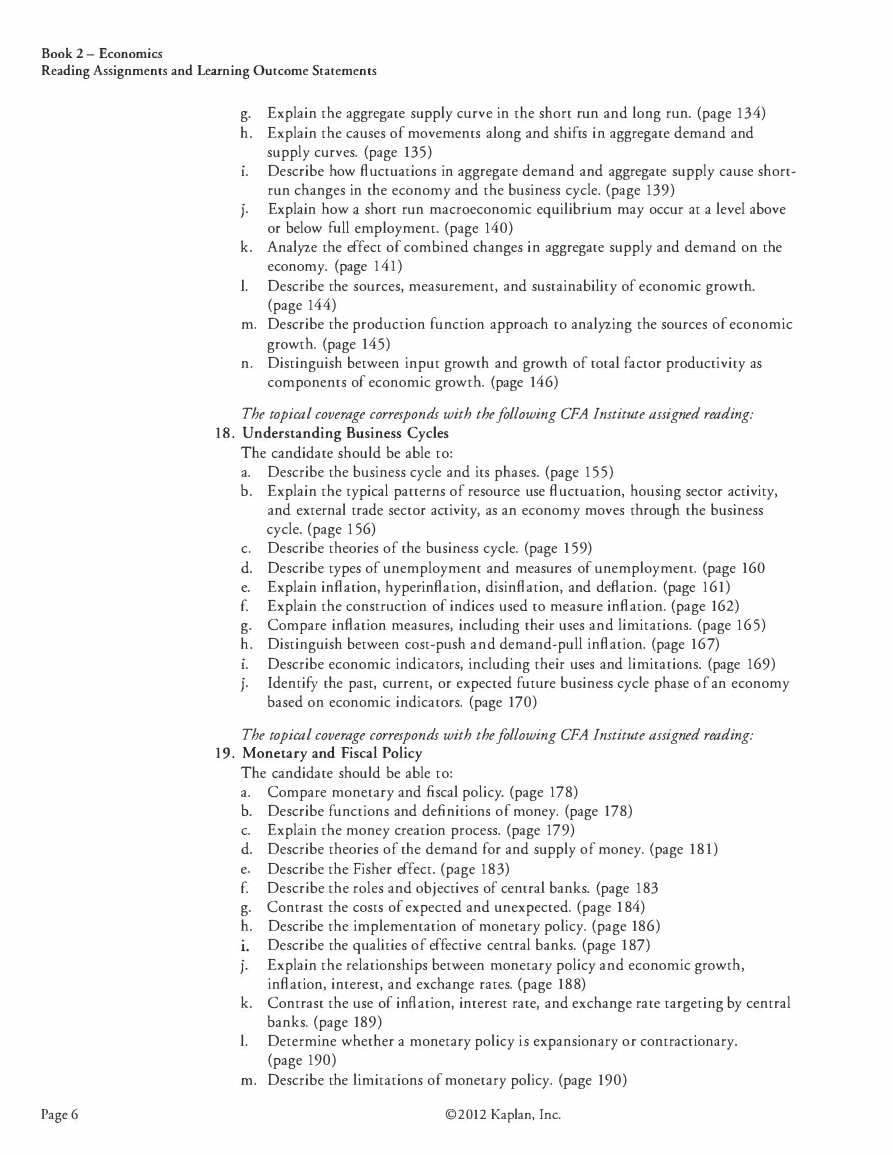
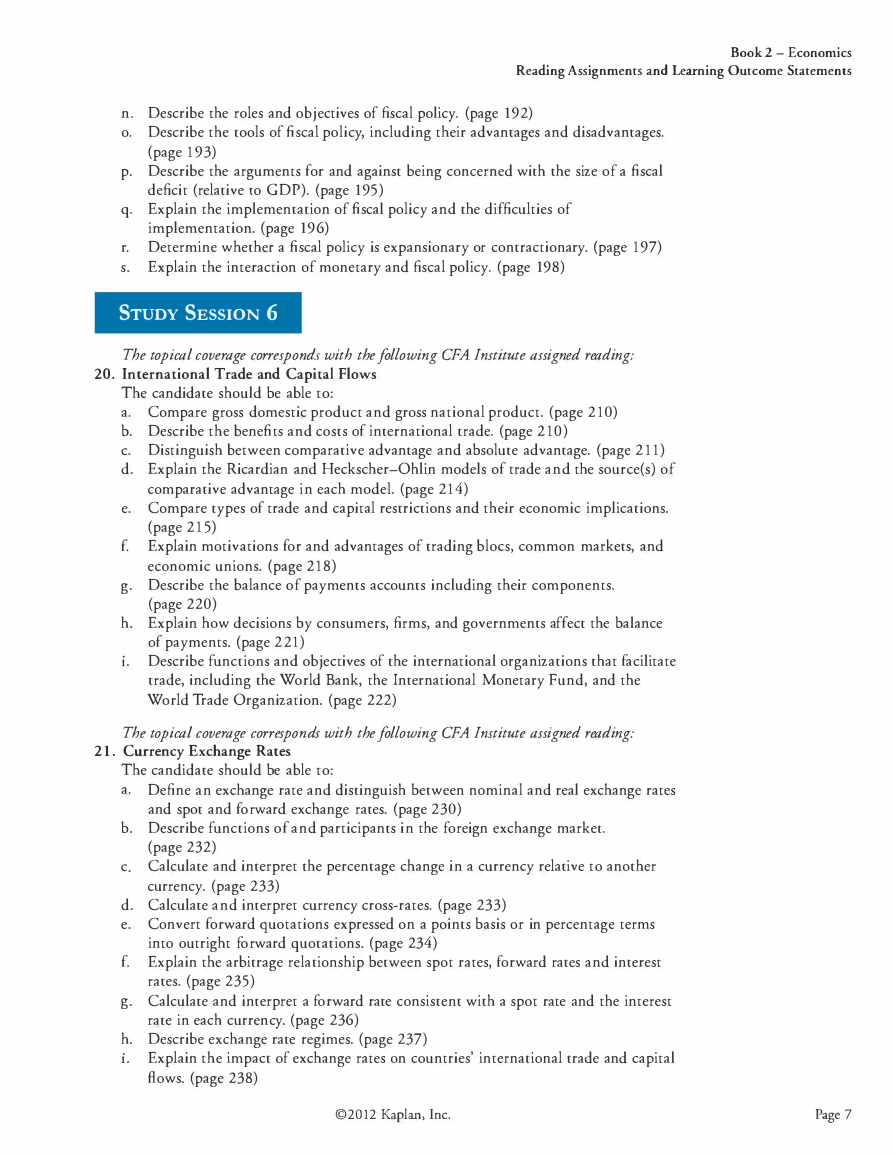








 2023年江西萍乡中考道德与法治真题及答案.doc
2023年江西萍乡中考道德与法治真题及答案.doc 2012年重庆南川中考生物真题及答案.doc
2012年重庆南川中考生物真题及答案.doc 2013年江西师范大学地理学综合及文艺理论基础考研真题.doc
2013年江西师范大学地理学综合及文艺理论基础考研真题.doc 2020年四川甘孜小升初语文真题及答案I卷.doc
2020年四川甘孜小升初语文真题及答案I卷.doc 2020年注册岩土工程师专业基础考试真题及答案.doc
2020年注册岩土工程师专业基础考试真题及答案.doc 2023-2024学年福建省厦门市九年级上学期数学月考试题及答案.doc
2023-2024学年福建省厦门市九年级上学期数学月考试题及答案.doc 2021-2022学年辽宁省沈阳市大东区九年级上学期语文期末试题及答案.doc
2021-2022学年辽宁省沈阳市大东区九年级上学期语文期末试题及答案.doc 2022-2023学年北京东城区初三第一学期物理期末试卷及答案.doc
2022-2023学年北京东城区初三第一学期物理期末试卷及答案.doc 2018上半年江西教师资格初中地理学科知识与教学能力真题及答案.doc
2018上半年江西教师资格初中地理学科知识与教学能力真题及答案.doc 2012年河北国家公务员申论考试真题及答案-省级.doc
2012年河北国家公务员申论考试真题及答案-省级.doc 2020-2021学年江苏省扬州市江都区邵樊片九年级上学期数学第一次质量检测试题及答案.doc
2020-2021学年江苏省扬州市江都区邵樊片九年级上学期数学第一次质量检测试题及答案.doc 2022下半年黑龙江教师资格证中学综合素质真题及答案.doc
2022下半年黑龙江教师资格证中学综合素质真题及答案.doc